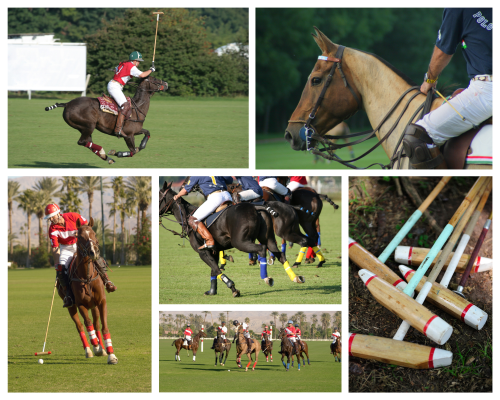With expert insights from Orthopedic Surgeon Dr. John Hinson
By Gianna Picard

Polo season may have ended, but here in Wellington, Florida—known as the Equestrian Capital of the World— it’s a year-round commitment for dedicated athletes. Polo is an intense, physically demanding sport that involves powerful swings and quick maneuvers on horseback, placing significant strain on the shoulder and elbow joints. This high-stakes sport requires stamina, bursts of speed and impact, balance, flexibility, and strength. Dr. John Hinson, a local orthopedic surgeon at Palm Beach Orthopaedic Institute specializing in shoulder and elbow care, shares tips on how athletes can optimize their recovery while training ahead for the next season.
- Have your shoulder health assessed– If lingering pain persists!
Polo places a high-load demand on your dominant arm. Microtrauma from repeated swinging motions can build up with or without symptoms, and you won’t even know until it becomes a problem. Sometimes microtrauma presents as stiffness, limited range of motion, catching, or a locking sensation. “Athletes should check in with their nearby orthopedic specialist for any pain that lingers,” said Dr. Hinson. An ultrasound or other diagnostic tests may be necessary for further evaluation. The goal is to catch minor injuries before a full-blown impingement, labral tear, or more serious injury.
2. Address imbalances between arms
The shoulder and elbow joints rely on the surrounding muscles for strength and stability, helping to support the bones and reduce the risk of sprains and injuries. That’s why it’s essential to keep these muscles strong and well-balanced. Polo’s one-sided nature puts the non-dominant arm and shoulder at risk of underdevelopment and joint injury. “Polo players should engage in strength training like dumbbell or band work with their non-dominant arm to maintain symmetry in the shoulder girdle, strength, and posture,” said Dr. Hinson. Beneficial exercises include reverse flys, rows, and rotator cuff stabilization. “As always, you’ll want to see your physician if you discover any pain or discomfort while exercising.”
3. Reduce inflammation the correct way
Inflammation is a natural response to the physical stress polo places on the body, especially after a demanding season. Addressing it properly is key to recovery and long-term joint health. “Players should take time to actively deload the shoulder and elbow,” said Dr. Hinson. “This includes 1-2 weeks of light mobility work, icing sore areas to reduce swelling, and avoiding overuse unless medically advised. Anti-inflammatory medications are an option to help reduce inflammation and joint symptoms. However, if symptoms persist after more than 1-2 weeks of use, a physician should be consulted for further evaluation.” Inflammation isn’t always a sign of damage, as it can be part of the repair process. Rest, ice, and controlled movement are often more effective than total immobility unless a confirmed injury occurs. When in doubt, consult with your orthopedic specialist.
4. Evaluate elbow strain or grip fatigue
The elbow joint often takes on more stress than expected, particularly in polo, where grip tension and repetitive mallet swings are constant. Over time, this can lead to fatigue or strain that originates not from the elbow but from improper grip mechanics or wrist overuse. Players should check for tenderness along the inside and outside of the elbow to properly monitor joint health. Light sensitivity in these areas may indicate an early sign of strain. Addressing it early can prevent potential chronic issues like tendinopathy from developing. Strengthening the wrist and forearm, while practicing a looser, more efficient grip, can ease the load on the elbow over time. “Overlooking minor aches or tenderness can lead to more serious injuries that may affect an athlete’s performance down the line.”
5. Consider a prehab plan, not just rehab
Injury prevention starts long before the first match of the season. Building shoulder stability, core strength, and balanced posture during the off-season can help polo players stay ahead of potential injuries. “Athletes who actively maintain shoulder function during the off-season tend to experience fewer issues when the season starts,” said Dr. Hinson. A consistent prehab routine–just 10 to 15 minutes, two to three times a week– can reinforce key areas like scapular control, rotator cuff strength, and core engagement. Rest days are just as important and should be built into the athlete’s schedule to allow the body time to recover and adapt. “Proper conditioning, recovery, and injury prevention are all part of being a year-round athlete.”
6. Strengthen smarter, not just harder
Building strength is essential for polo performance, but how you train matters just as much as how hard you train. Overloading the shoulder with traditional heavy lifts can sometimes do more harm than good. “Heavy overhead presses or dips aren’t always the best choice for shoulder health, particularly in the post-season,” said Dr. Hinson. “It’s athlete-specific, but heavier weights could prove harmful in some instances.” A smarter approach focuses on strengthening the smaller stabilizing muscles that support shoulder mechanics and mallet control. Targeted exercises such as incline push-ups, resistance band external rotations, and eccentric loading work can improve endurance and joint integrity. “Athletes should prioritize movements that build durability, not just power,” Dr. Hinson added. Developing strength with intention–through control, balance, and correct technique–helps reduce the risk of injury and supports long-term performance in the athlete.
Overall, polo athletes can keep their shoulders and elbows healthy in the off-season and perform at their best by following these expert tips from Dr. Hinson. Remember, maintaining joint health is an ongoing commitment. Beyond polo season, athletes should continue to focus on injury prevention, strengthening, and recovery when engaging in sports training and in the sport itself. Dr. Hinson advises all athletes to be mindful of their bodies, and if engaging in the sport or athletic training exercises causes pain, stop immediately and consult with a provider.
To learn more about Dr. Hinson and the Palm Beach Orthopaedic Institute, visit https://www.pboi.com/john-hinson.

